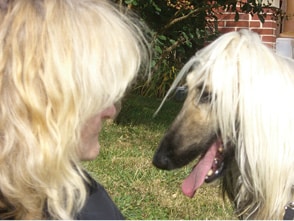I have been thinking a lot the last month—sometimes we have to look back before we can look forward. This reminded me of Winston Churchill’s famous WWII saying:
“The farther back you can look, the farther forward you are likely to see.”
I started reminiscing and looking at the way things have evolved over the last many decades. What lessons can we learn from the people in past decades as to what worked for the best, and what could have been done better?
Breeders & Bloodlines
In the past, breeders would travel to buy and breeders would sell. Today, breeders or exhibitors travel to show their dogs, and few breeders have anything they can sell since they are caught between laws and peer pressure; condemnation if they breed “too often.”
I was thinking of two great dog shows: Crufts and Westminster. The major difference between then and now is that only in this century has there been a number of foreign dogs being exhibited. But in the last century, there were foreign visitors who attended both shows to meet breeders and buy dogs or puppies. This was a good thing for all breeds, as bloodlines could be shared with breeders around the world. I know that in my own breed there were “regulars” who visited Crufts every year from Europe and the Americas who would be able to take something home with them. Today that would not be possible in probably most breeds, as few breeders would have anything available. I really enjoyed meeting the overseas visitors and getting to know them, learning about their dogs and dog shows in their country.
Another thing that may still happen in some breeds today is that foreign visitors would make or be taken on kennel visits. On my first visit to the US, I was staying outside NYC and some people from Canada drove down to take me to visit some Canadian kennels! I was also taken to visit kennels in the US. When I was still living in England, I would receive phone calls from people who wanted to visit me.
The one that took me by surprise was a phone call at 10:30 p.m. The phone rang, and an American voice announced, “This is Sunny Shay, we are coming over to see you and I want to see the dogs!” Yes, she was on her way. So, at midnight, we were out there running dogs up and down the driveway!
Those visits were a great way to learn about the dogs in other countries and talk with the breeders and owners themselves, sharing opinions and knowledge.
What lessons can we learn from the people in past decades as to what worked for the best, and what could have been done better?
Dog Owners or Pet Parents?
The big change after WWII was the rise of the middle class, which found showing dogs to be an enjoyable activity—many becoming dedicated breeders. They would have a few show dogs to start with, but when they started breeding they would have their adults and some growing puppies (some of which would be available to new exhibitors but not enough that would necessitate hiring kennel staff). Moving forward from the 1970s to now, we see HOAs and local zoning regulations limiting the number of dogs a person can own.
The Animal Rights (AR) movement was born in the ‘70s, but it was not until the ‘80s that the “snake under the porch” woke up and rattled. At first their rhetoric was just against puppy mills, but one person of influence launched the first salvo against private non-commercial breeders in the mid ‘80s by making the word “kennel” a dirty word. Yes, words matter. The ARs would like us to be “guardians” and not “owners,” and the use of phrases like “pet parent” and “fur babies” are now in common usage.
From Vast Estates to Modern Living
Chatting about this with other people in the dog show world online recently, many things we have been told may have been correct at the time they were first said but when people reiterate the same things 20 or 30 years later they become meaningless. I think of this when I see references to the “large” kennels of the past. With a few exceptions, that was a long time ago. Before WWII there were people with sprawling estates in the UK and in the US, some of which survived after the war. These were people with “old money” as we call it now. Today, the wealthy are less likely to be breeders but will be highly successful exhibitors and sponsors instead.
During my conversations, several people have mentioned that they miss the benched shows which created a feeling of community, with friendships being made with people in other breeds as well as your own. People would talk about breeding plans back then, but today, very few people can claim to have a breeding program due to the more and more stringent zoning regulations.
As one person said, “It is hard to develop a line of dogs if you cannot keep one or two and watch them grow out.” Even those who are fortunate enough to have the ability to do so may be afraid of putting up a website for fear of the ARs or an angry neighbor. I knew of a successful breeder/exhibitor who stated that anyone who advertised on the Internet or had a website was a puppy mill! Then they wonder why the people I have called “off-grid breeders” have been able to make connections. These days, people only discuss their plans with their close friends.
….people have mentioned that they miss the benched shows which created a feeling of community, with friendships being made with people in other breeds as well as your own.
Us vs. Them
Another person posted online that they felt too much emphasis is placed on ranking systems today; that the dog world has become too factionalized (owner-handlers vs. pro handlers, oldies vs. newbies) and that most exhibitors are ribbon and ranking chasers and not breeders. I am not surprised. There has been so much indoctrination into thinking breeding is something that they should NOT be doing. Maybe it is time people started to encourage newcomers who want to do it the right way, instead of pulling out the pitchforks and torches!
I think statistics have been another killer. Too many people want all-champion litters instead of letting some of the puppies go to pet homes. Stud dogs are being rated by how many champions per litter rather than by the value of what they have sired.
On the subject of social media, it was described as a two-edged sword. One person said that the good part was being able to make connections with people overseas; important to people with newly recognized breeds or those needing fresh bloodlines. Another said, “The negative side has been that it has destroyed breed magazines. Why take out a paid ad after a win, when you can post it (on Facebook) for free? But with the demise of print magazines, there is no history or record of dogs that will last for years.”
Old School & New Threats
Others regretted the loss of so many “old school” judges with many years of knowledge and experience, when shows and classes had bigger entries, and that in some breeds dog showing has now become a grooming contest.
In case anyone out there has not noticed, there have been at least three, to my knowledge, serious, almost copycat anti-breeder bills on the table in different states. The most recent of these are in Florida and Colorado. Everyone in every state needs to keep watch on what is happening in their own state.
In closing, I would like for people to think:
- What small things can we all do?
- Can we keep tabs on legislative issues?
- Can we help a newcomer buy a proper show lead?
- Can we bring someone a coffee so that they don’t have to leave their dogs?
There must be something we can all do!









